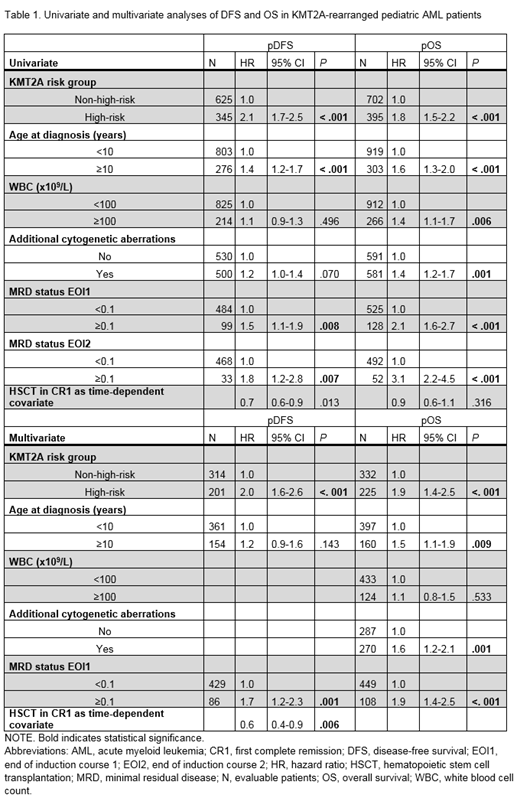Abstract
Introduction
KMT2A-rearranged (KMT2A-r) acute myeloid leukemia (AML) is a heterogeneous genetic subgroup with a frequency of about 25% in children with AML. At the 62 nd ASH annual meeting last year, we reported on the differences in outcome of various KMT2A subgroups based on translocation partner and the significance of minimal residual disease (MRD) status during and after induction as a follow-up study of Balgobind et al., Blood 2009. The impact of allogeneic hematopoietic stem cell transplantation (allo-HSCT) in first complete remission (CR1) and the presence of additional cytogenetic aberrations (ACAs) on prognosis have not yet been described for our cohort.
Methods
Data on allo-HSCT in CR1 and the presence of ACAs of 1256 KMT2A-r de novo pediatric AML patients from 15 AML study groups affiliated with the I-BFM Study Group, diagnosed between 2005 and 2016, were retrospectively collected and studied. Karyotypes were reviewed and classified by two of the authors (RW&CH). Based on translocation partners, patients were classified to the KMT2A high-risk subgroup (6q27, 10p11.2, 10p12, 4q21, and 19p13.3) or non-high-risk subgroup (9p22, 19p13, 19p13.1, 1q21, Xq24, 17q21, 1p32, and 17q12). These two categories have been used to estimate a Cox model. Patients with unknown translocation partners were excluded from these analyses (n=126). Flow cytometry MRD levels at the end of induction course 1 (EOI1) and 2 (EOI2) <0.1% were considered negative, and levels ≥0.1% positive. Kaplan-Meier's methodology was used to estimate disease-free survival (DFS) and overall survival (OS). DFS was calculated from EOI1 for patients in CR to date of relapse or death/last follow-up. OS was calculated from the time of diagnosis to date of death/last follow-up. Two-sided P-values of ≤ .01 were considered statistically significant. Covariates with P-values ≤ .05 in univariate analyses were included in multivariate analyses; allo-HSCT in CR1 was included as a time-dependent covariate in the Cox model. MRD status at EOI2 was excluded from multivariate analyses as therapy could have been adjusted to the MRD status and the number of MRD positive patients was small.
Results
Of 1256 pediatric patients with KMT2A-r AML, data on HSCT in CR1 and ACAs were available for 1186 (94.4%) and 1204 patients (95.9%), respectively; 211 (17.8%) patients received HSCT in CR1 and ACAs were present in 601 (49.9%) patients. Compared with the KMT2A non-high-risk subgroup, patients in the KMT2A high-risk subgroup underwent HSCT in CR1 more often (23.8% vs 15.0%; P < .001). ACAs were borderline significantly more common in the KMT2A high-risk subgroup (54.1% vs 46.4%; P = .015).
Univariate analysis of the probability of DFS (Table 1) showed that the KMT2A high-risk subgroup (HR 2.1; 95% CI, 1.7-2.5), age ≥10 years (HR 1.4; 95% CI, 1.2-1.7), and MRD ≥0.1 at EOI1 (HR 1.5; 95% CI, 1.1-1.9) were associated with DFS. HSCT in CR1 was a borderline significant prognostic factor (HR 0.7; 95% CI, 0.6-0.9).
In a multivariate analysis for DFS (n=515) (Table 1), the KMT2A high-risk subgroup (HR 2.0; 95% CI, 1.6-2.6), MRD ≥0.1 at EOI1 (HR 1.7; 95% CI, 1.2-2.3), and HSCT in CR1 (HR 0.6; 95% CI, 0.4-0.9) were associated with DFS.
Univariate analysis of the probability of OS (Table 1) showed that the KMT2A high-risk subgroup (HR 1.8; 95% CI, 1.5-2.2), age ≥10 years (HR 1.6; 95% CI 1.3-2.0), WBC ≥100 x10 9/L (HR 1.4; 95% CI, 1.1-1.7), the presence of ACAs (HR 1.4; 95% CI, 1.2-1.7), and MRD ≥0.1 at EOI1 (HR 2.1; 95% CI, 1.6-2.7) were associated with OS. HSCT in CR1 was not associated with OS. The effect of HSCT in CR1 was not significantly different between the KMT2A high-risk and non-high-risk subgroups.
In a multivariate analysis for OS (n=557) (Table 1), the KMT2A high-risk subgroup (HR 1.9; 95% CI, 1.4-2.5), age ≥10 years (HR 1.5; 95% CI, 1.1-1.9), the presence of ACAs (HR 1.6; 95% CI, 1.2-2.1), and MRD positivity at EOI1 (HR 1.9; 95% CI, 1.4-2.5) were associated with OS.
Conclusions
In this cohort of KMT2A-r pediatric AML patients, the presence of ACAs at diagnosis was independently associated with inferior OS, but not with DFS. This may be due to the exclusion of refractory patients in DFS analysis, who were significantly more common in the group of patients with ACAs. Analysis has yet to be performed to distinguish karyotype complexity. In addition, allo-HSCT in CR1 was an independent predictor of improved DFS, but was not a prognostic factor for OS.
Abrahamsson: wedish Children´s Cancer Foundation. Research grants and 50% senior research position for clinical research on pediatric leukemia: Research Funding. Locatelli: Amgen: Membership on an entity's Board of Directors or advisory committees, Speakers Bureau; Novartis: Membership on an entity's Board of Directors or advisory committees, Speakers Bureau; Miltenyi: Speakers Bureau; Medac: Speakers Bureau; Jazz Pharamceutical: Speakers Bureau; Takeda: Speakers Bureau.


This feature is available to Subscribers Only
Sign In or Create an Account Close Modal